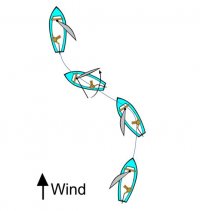Perhaps a picture would help.
Maybe a word picture?
Imagine running downwind in breeze, starboard gibe. Main is all the way out against the port shrouds.
To start this thing, turn to port... how aggressively you turn depends on a number of things, not the least of which is the size/spacing of the waves. You generally want to do this between waves, not be in the middle of the gibe at the top of a wave. It should be a real "turn", though, maybe 20-30 degrees of heading.
At some point, as you turn to port, the leech of the main will start to collapse as the sail begins to feel breeze on its leeward side. At that point there's MUCH less load on the main than there was previously.
Grab the mainsheet and snap it to start the main swinging through. When it gets to the other side, it will be luffing (because you're headed "up" a 20-30 degrees on the new gibe). It won't make a big crashing sound. Honest.
Then fall off to starboard to get back on course. You're now on port gibe, running with the main against the starboard shrouds.
It's called the "slalom" technique because, if you look back, you'll see a big "S-turn" carved in the face of the wave coming up behind you.
I spent a bunch of time on fully-crewed "sleds" (70-foot ultra-lights) that used this technique in open ocean.... and can assert that this works great, even in big waves, even with a 25-foot boom on the bottom of a 750-square-foot main. It depends on a good driver and - if the rig has them - good people on the running backs. But ends up being far less stress on the rig than grinding it in on one side and letting it slam against the rig - or pin the boat down - on the other.
Edited to add: crude attempt at a picture

_/)_
Bruce
Last edited:

